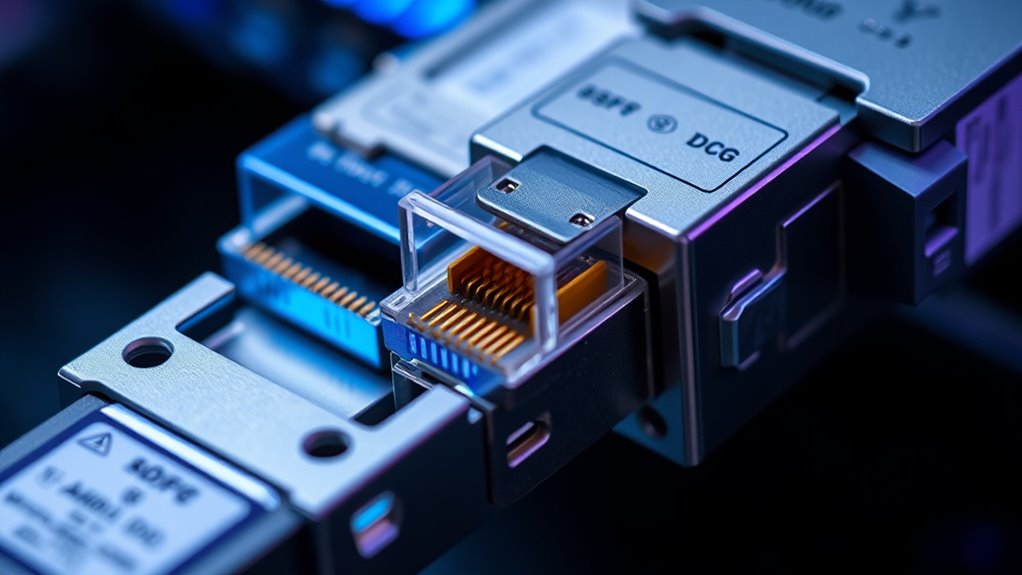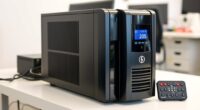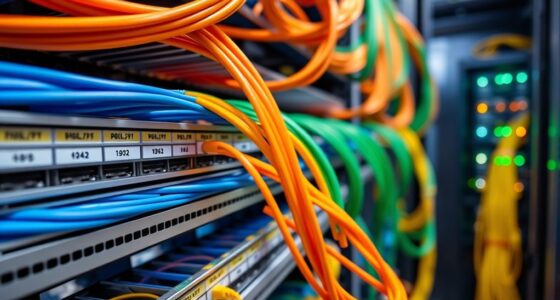Understanding QSFP‑DD and OSFP is essential for selecting the right modules for your 400G network. QSFP‑DD offers high port density, fiber flexibility, and supports both multimode and single-mode fibers, making it versatile for various setups. OSFP emphasizes better thermal management, ideal for dense, high-performance environments. Knowing their differences helps you optimize scalability, performance, and future readiness. Exploring further will give you detailed insights to make informed infrastructure decisions.
Key Takeaways
- QSFP‑DD and OSFP are high-speed standards supporting 400G networking with different form factors and fiber compatibility options.
- QSFP‑DD offers high port density and flexibility for multimode and single-mode fibers in data centers.
- OSFP emphasizes enhanced thermal management, suitable for dense, high-performance environments.
- Both modules support hot-swapping and scalable deployment, but differ in size, heat dissipation, and fiber support.
- Selecting between QSFP‑DD and OSFP depends on infrastructure needs, space constraints, and future scalability.

As 400G networking becomes increasingly essential for data centers and telecommunications, understanding the key interconnect technologies is critical. Two prominent standards, QSFP‑DD (Quad Small Form-factor Pluggable Double Density) and OSFP (Octal Small Form-factor Pluggable), are shaping how you deploy high-speed connections. These modules are designed to handle the demanding bandwidth needs of modern networks, but their differences in fiber compatibility and port density can considerably influence your infrastructure choices. Recognizing these aspects helps you optimize your data center’s performance and scalability.
QSFP‑DD modules are known for their versatility and broad fiber compatibility. They support various transceiver types, including both multimode and single-mode fibers, enabling you to tailor solutions based on your existing infrastructure. This flexibility simplifies upgrades and expansions, especially when your network needs to support different fiber types across multiple links. Additionally, QSFP‑DD offers high port density—typically fitting into a single 1U or 2U chassis, you can deploy many ports within a limited space. This density allows you to maximize your rack space efficiently, reducing physical footprint and easing cable management. The ability to pack more connections into a smaller area means you can scale your network without overhauling your hardware setup.
QSFP‑DD offers versatile fiber support and high port density for flexible, scalable data center networking.
In contrast, OSFP modules are engineered with a focus on high performance and thermal management, which is essential in high-density environments. They are often compatible with a similar range of fiber types but are particularly optimized for single-mode fiber, making them suitable for long-distance links. While OSFP supports comparable port densities to QSFP‑DD, its design emphasizes better heat dissipation, allowing you to operate more modules in tight spaces without overheating. This feature is especially beneficial if your data center requires dense interconnects with reliable thermal performance. thermal management is a critical aspect that affects the overall efficiency and longevity of high-density networking equipment.
Both standards support pluggability and hot-swapping, but their form factors differ, impacting fiber compatibility and port density planning. QSFP‑DD’s slightly smaller size can enable more ports per chassis, but OSFP’s thermal advantages may justify its slightly larger footprint in high-performance setups. Ultimately, your choice hinges on your specific fiber infrastructure, whether you prioritize fiber compatibility flexibility or thermal efficiency for dense deployments. By understanding these distinctions, you can make informed decisions that align with your scaling goals, ensuring your network remains robust, scalable, and ready for future demands.
Frequently Asked Questions
How Do QSFP-DD and OSFP Compare in Power Consumption?
You’ll find that QSFP-DD typically offers better power efficiency than OSFP, meaning it consumes less energy for the same performance. While both modules are designed for high data rates, OSFP tends to have higher energy consumption due to its larger size and additional features. If reducing power consumption is your priority, QSFP-DD might be the better choice, helping you optimize energy efficiency without sacrificing network performance.
Are QSFP-DD and OSFP Compatible With Existing 400G Infrastructure?
Think of your existing 400G infrastructure as a well-worn bridge—QSFP-DD and OSFP can often cross it, but not always seamlessly. While both are designed to be compatible with some legacy systems, deployment considerations matter. You might need adapters or upgrades to guarantee smooth integration. Check your hardware specs and vendor support to confirm compatibility, helping you avoid surprises and keep your network running efficiently.
What Are the Cost Differences Between QSFP-DD and OSFP Modules?
You’ll find that QSFP‑DD modules generally cost less than OSFP modules due to lower manufacturing costs and simpler design. Market adoption also influences prices; QSFP‑DD is more widely adopted, driving economies of scale. OSFP modules tend to be pricier because of their advanced features and higher manufacturing costs. Overall, if budget is a concern, QSFP‑DD offers a more cost-effective option, especially as market adoption continues to grow.
How Do Cooling Requirements Differ for QSFP-DD and OSFP?
Think of cooling like clearing a crowded hallway—better airflow keeps everyone moving smoothly. OSFP modules generate more heat than QSFP-DD, requiring enhanced thermal management and airflow optimization. You’ll need larger heatsinks and better ventilation for OSFPs to prevent overheating. QSFP-DDs, being smaller, need less cooling. So, your cooling setup must adapt, ensuring each module stays within safe temperatures for reliable performance.
What Are the Future Scalability Prospects of QSFP-DD Versus OSFP?
You’ll find that OSFP offers greater future scalability than QSFP‑DD due to its larger form factor, higher port density, and support for higher data rates like 800G and beyond. While QSFP‑DD is suitable for current 400G needs, OSFP’s design allows for easier upgrades as technology advances. If you plan for long-term expansion, OSFP provides more flexibility and capacity to meet future networking demands.
Conclusion
Think of QSFP-DD and OSFP as the engines driving your 400G network train. Choosing the right one secures your system’s speed, efficiency, and future growth. Just like selecting a powerful engine ensures a smooth ride, understanding these standards guarantees your network stays ahead of the curve. By making informed decisions now, you’re setting the track for a faster, more reliable journey into the future of high-speed networking.







